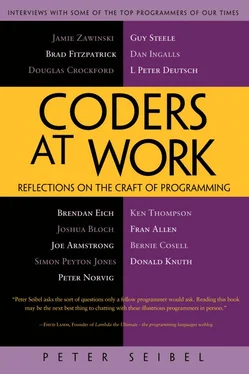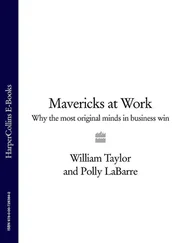Peter Seibel - Coders at Work - Reflections on the craft of programming
Здесь есть возможность читать онлайн «Peter Seibel - Coders at Work - Reflections on the craft of programming» весь текст электронной книги совершенно бесплатно (целиком полную версию без сокращений). В некоторых случаях можно слушать аудио, скачать через торрент в формате fb2 и присутствует краткое содержание. Жанр: Программирование, на английском языке. Описание произведения, (предисловие) а так же отзывы посетителей доступны на портале библиотеки ЛибКат.
- Название:Coders at Work: Reflections on the craft of programming
- Автор:
- Жанр:
- Год:неизвестен
- ISBN:нет данных
- Рейтинг книги:3 / 5. Голосов: 1
-
Избранное:Добавить в избранное
- Отзывы:
-
Ваша оценка:
- 60
- 1
- 2
- 3
- 4
- 5
Coders at Work: Reflections on the craft of programming: краткое содержание, описание и аннотация
Предлагаем к чтению аннотацию, описание, краткое содержание или предисловие (зависит от того, что написал сам автор книги «Coders at Work: Reflections on the craft of programming»). Если вы не нашли необходимую информацию о книге — напишите в комментариях, мы постараемся отыскать её.
Coders at Work
Founders at Work
Coders at Work: Reflections on the craft of programming — читать онлайн бесплатно полную книгу (весь текст) целиком
Ниже представлен текст книги, разбитый по страницам. Система сохранения места последней прочитанной страницы, позволяет с удобством читать онлайн бесплатно книгу «Coders at Work: Reflections on the craft of programming», без необходимости каждый раз заново искать на чём Вы остановились. Поставьте закладку, и сможете в любой момент перейти на страницу, на которой закончили чтение.
Интервал:
Закладка:
It was well recognized that the compiler was going to be key to the success of the machine and that the biggest challenge to achieve that performance was going to be access to memory and that the compiler played a big role in that.
Seibel:Because dealing with the memory latency was going to be more complex than programmers writing assembly by hand were going to be able to handle?
Allen:Yes. And because the memory-latency problem was being solved by a lot of concurrency in the hardware—very complex concurrency. And the memory organization itself was multiway-interleaved and it was unpredictable what order data would be delivered to the computational unit. Six accesses could be in flight at the same time. There were pipelines in the computational unit itself and there was an ability for multiple instructions to be in execution at the same time. And the most complicated unit on the machine was a look-ahead unit, because they had precise interrupts as part of the architectural design, so not only did it have to keep track of all the concurrency going forward, but they had to back it out when there was an interrupt.
It was an extremely complicated machine and a wonderful one to program. The compiler had a very big challenge in order to take advantage of it. It was a wonderfully challenging project.
So a bunch of us were drafted out of Research to come and work on the compiler and the operating-system software itself. The compiler itself was as grandiose as the machine. I ended up, because of my previous exposure to the Fortran optimizer, involved with the optimizer for the Stretch machine—the Stretch Harvest, as it turns out. The outlines of the compiler were established by a different committee but there were four of us who were given the charge of filling in the details, including the interfaces in the compiler and what the specs were for that and taking charge of the different pieces of it. I had the optimizer, and somebody else had the parser, the register allocator, and the interface with the assembly program.
Seibel:How was the project structured in terms of the technical people working on it?
Allen:Well, there were around three people who laid out the overall design of the compiler—we’re going to have a parser, we’re going to have this and that, and then where it fit. And there was somebody above them—this was a product, so there were more layers of decision-making and management.
Then they needed to have project overseers for each of the big components. So they asked four of us, three of us being women, to get involved, to get together as a team and design the interfaces.
Seibel:And then were there other programmers working on the actual implementation?
Allen:Yes. I had a group of 17, all doing programming.
Seibel:What was the relation between the design phase and the coding? You four got together and sorted out the interfaces between the parts. Did that all happen before your 17 programmers started writing code, or did the coding feed back into your design?
Allen:It was pretty much happening as we went. Our constraints were set by the people we reported to. And the heads of the different pieces, like myself, reported to one person, George Grover, and he had worked out the bigger picture technically. And a lot of it was driven by the constraints of the customers. There was a lot of teamwork and a lot of flexibility at the time, in part, because we were kind of inventing as we went. But under a deadline. So there was not as much management hierarchy, but just being more part of the team.
Seibel:Did the people below you ever write code that would then force the realization that some of the higher-up decisions about how the pieces were going to fit together had to be revisited?
Allen:Yes, how this interface is not going to work. Keeping track of how things were coming together was a part of it. We would meet as a team, the four of us. But most of our time was spent on trying to build the component that we were responsible for—there was a lot of freedom.
Software engineering came much later. There wasn’t software engineering and there weren’t big processes set up yet. On a subsequent project, the 360, run by Fred Brooks, which I wasn’t involved with, the software was a huge crisis. The engineering on the 360 was doing pretty well around ’63. And some engineers moved over from building the machines—hardware engineers—guys that just knew nothing about software—to run the software because it was so out of hand. And it was really a mess.
After the 360 got shipped one of the people—I don’t know that he’d been involved with the 360—wrote a letter to the higher-ups in IBM proposing a software-engineering discipline called Cleanroom. He made statement that if you followed all these set of processes he was laying out, you could write perfect programs. And because of what management had been through—this is my version—they bought the whole thing.
Seibel:Because the 360 project had been so painful?
Allen:That’s right. So IBM product development moved very strongly over to the Cleanroom processes—a whole set of processes. One of the things was that there would be somebody that would set objectives and there would be another group that did the design. And the designers would specify the design to the detail that the programmers could write to the designs. And these groups were not interactive—you just did this cleanly enough, and perfect software came out.
Seibel:On the 360 project, Brooks was in charge of both software and hardware, right?
Allen:Yes, I think he had the whole thing. But he replaced some of the software heads with people with hardware experience. And it was really the right thing to do because the hardware people already had a wonderful discipline around building hardware—the chip design and the testing process and all of that. And that was an older and much more rigorous ways of expressing designs. We software people were just making it up.
Seibel:So you feel that, at least on that project, that they brought something to the software-development process that saved the project?
Allen:It was absolutely necessary, but it was so painful for the software people to have these guys—all guys—move in, knowing nothing about software, and just impose design reviews, design specs, all of this stuff.
Seibel:So it did help save that project. Did that embolden folks to take this next step to the Cleanroom process that was sort of a step too far?
Allen:Yeah, I think it did. That was the sequence. And the Cleanroom process, the waterfall process, came in through management with a very strong advocate for it.
Seibel:And that advocate was from the hardware side?
Allen:No, the advocate was from the software side. But I don’t think that he had been part of the 360 project, in the depths of trying to rescue that. But some of us who already had some experience with software structure were appalled at the statements at the time. But sometimes one has to make bold claims in order to sell something.
Seibel:Did you ever work on a project where that kind of process was used?
Allen:Oh, yes. And found it frustrating because in its early stages, a designer and the programmer could not interact. One of the problems was—probably still is—that the life cycle of a piece of software is very long. And at that time, if you were building a big piece of software, it took months and months or years. And the environment changed and the requirements changed. And the customers really did have the say in what they wanted in the end.
Читать дальшеИнтервал:
Закладка:
Похожие книги на «Coders at Work: Reflections on the craft of programming»
Представляем Вашему вниманию похожие книги на «Coders at Work: Reflections on the craft of programming» списком для выбора. Мы отобрали схожую по названию и смыслу литературу в надежде предоставить читателям больше вариантов отыскать новые, интересные, ещё непрочитанные произведения.
Обсуждение, отзывы о книге «Coders at Work: Reflections on the craft of programming» и просто собственные мнения читателей. Оставьте ваши комментарии, напишите, что Вы думаете о произведении, его смысле или главных героях. Укажите что конкретно понравилось, а что нет, и почему Вы так считаете.












